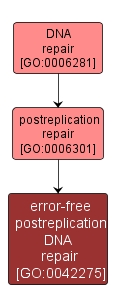GO TERM SUMMARY
|
| Name: |
error-free postreplication DNA repair |
| Acc: |
GO:0042275 |
| Aspect: |
Biological Process |
| Desc: |
The conversion of DNA-damage induced single-stranded gaps into large molecular weight DNA via processes such as template switching, which does not remove the replication-blocking lesions and but does not increase the endogenous mutation rate. |
Synonyms:
- error-free PRR
- error-free replication restart
|
|

|
INTERACTIVE GO GRAPH
|














